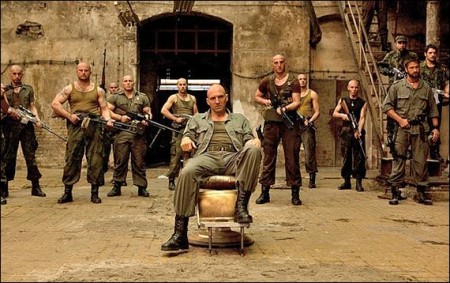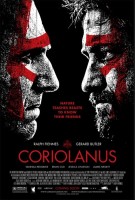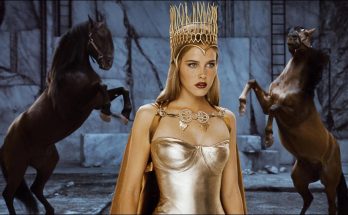Taglines: Nature teaches beasts to know their friends.
The film is based on the William Shakespeare tragedy, about the life of the legendary Roman leader, Gaius Martius Coriolanus. But none of the talent will be donning sandals or unsheathing swords in this adaption of Shakespeare’s Roman tragedy. Update is billed as a political thriller and brings the story into a contemporary setting.
Gerard Butler stars opposite Ralph Fiennes in what is billed as a contemporary version of Shakespeare’s Rome-set political and family drama. Butler will play Tullus Aufidius, commander of the Volscian army from Shakespeare’s play.
About the Production
Ralph Fiennes’ ambition to make a film of William Shakespeare’s “Coriolanus ” took root when the actor played the role in an acclaimed production directed by Jonathan Kent for the Almeida Theatre in 2000. Fiennes lived with the play and the role for a substantial length of time: the production originated at the Gainsborough Studios in London and subsequently traveled to the New York’s Brooklyn Academy of Art (BAM) and Tokyo’s Akasaka ACT Theater, wrapping up its run at the end of October 2000. With its charismatic, flawed military hero; ferocious battle sequences; coolly trenchant observation of political and social dysfunction; and intimate family portrait, “Coriolanus ” had plenty of excitement and intrigue to fill the big screen. “I became obsessed with the play and the role and felt it could be very cinematic, ” Fiennes explains. “I thought that its narrative drive would lend itself to film. The thought stayed, and developed, in my mind.”
Fiennes felt the story would easily work in a contemporary setting — war, political maneuvering, civil unrest and personal struggle being as endemic to the 21st Century as they were to Shakespeare’s Renaissance and Coriolanus’ Roman Republic. The Russia/Chechnya conflict and the recent political tensions in Colombia were useful references as he fleshed out his concept. He envisioned Rome as a quintessential global capital, with a diverse population and pervasive economic and social inequality; the Volsces became a kind of separatist insurgency, a scrappy guerrilla movement in opposition to Rome’s organized military. The deeper he got into the material, the more certain he became that he not only wanted to portray the title character, he wanted to direct, as well.
By the mid-2000s, Fiennes was ready to take the step of turning his ideas into a screenplay. He found an ideal collaborator in writer John Logan, the Tony Award-winning playwright of “Red ” and Academy Award-nominated screenwriter of GLADIATOR and THE AVIATOR. Logan, himself a lover of Shakespeare, responded immediately and enthusiastically to Fiennes’ ideas and signed on to write the screen adaptation. “Ralph and I saw the play in exactly the same way – raw and contemporary, ” Logan affirms. “Neither of us was interested in doing a polite museum-piece.”
Fiennes had already homed in on ways to streamline the text for a modern adaptation, and Logan reacquainted himself with the play and did the same. Then two men spent about a week together going through Shakespeare’s play, scene by scene, line by line, deciding what to cut and how to make the story move at a brisk cinematic pace. “We sat and chucked ideas back and forth and John noted them all down, ” recalls Fiennes. “The key thing I felt strongly about it setting it in the present, not some indeterminate period. So everything in the film is what we see in today’s world: suits, cars, graffiti, cell phones. And our ‘Rome’ is not Rome, Italy; our Rome is a city today. I think we had a first draft within eight weeks, and we kept refining from there.
Their approach was to retain Shakespeare’s dialogue, though in considerably less length. Some speeches were shortened and some were moved to different parts of the text. They made other adjustments to give the screenplay directness, clarity and contemporary authenticity. For example, the play’s First and Second Citizens became the underground antigovernment activists Cassius and Tamora; the pros and cons of candidate Coriolanus were hashed out by television pundits, instead of citizens in the marketplace.
Their work led to Logan’s taut, forceful screenplay, which runs just over 100 pages and immediately introduces a city on the brink, its class divisions glaringly exposed by a food shortage. When the future Coriolanus first appears in the flesh, it’s at the head of a phalanx of police in full riot gear. Says Logan, “What Ralph and I always wanted to capture was the way the play makes you feel in the theatre: it hits you like a fist.”
Both Fiennes and Logan served as producers on CORIOLANUS. Joining them on the production team were Gabrielle Tana, whom Fiennes first approached while they were working on the 2008 drama THE DUCHESS; Julia Taylor-Stanley, whose credits include Julie Taymor’s THE TEMPEST; and Colin Vaines, who produced A DANGEROUS MAN: LAWRENCE AFTER ARABIA, the television film that launched Fiennes’ star as an onscreen leading man.
The three seasoned producers were easily persuaded to join Fiennes in his first filmmaking venture. “The combination of Ralph’s vision and John’s script made us all passionate about getting the film made, ” Taylor-Stanley notes. “One of the great things about ‘Coriolanus’ is that it’s so little known as a play and yet it’s one of Shakespeare’s finest works. The themes are so relevant: a hungry population, economic uncertainty, the threat of anarchy, and an authoritarian backlash. Ralph knew the play inside-out, he knew the part inside out, and most importantly, he knew exactly what he wanted to do in bringing it to the screen.”
From the earliest stages of developing CORIOLANUS, Fiennes knew he wanted Vanessa Redgrave for the key role of Coriolanus’ mother, Volumnia. Aristocratic and patriotic, Volumnia had molded her only son for battle virtually from the cradle. Redgrave was eager to work with Fiennes as both an actor and director, but she worried about her ability to burrow into the skin of a character whose mindset was so different than her own. She finally found a window onto Volumnia by looking at her own family’s years of service in the British military. Redgrave’s grandfather fought in World War I and went on to become headmaster at the Royal Naval College, where he trained the officers who would ultimately serve in World War II. Two of Redgrave’s uncles fought in Second World War; one was killed in battle in the Pacific, and another recuperated at her family’s home after his ship was bombed. The actress had her own childhood memories of World War II and the hours her family spent gathered at the radio. “We listened to the weather forecast all around the British Isles every night as a matter of life and death. The Merchant Navy would be trying to avoid German submarines so they could make port and bring food to the country, ” Redgrave says. “I realized there’s a very specific, dedicated mentality held in military families. People are ready to sacrifice their lives, and mothers are ready for their sons to be sacrificed. I had to understand that if I was to play Volumnia.”
She continues, “Volumnia is a military woman, and her pride is in the history of her family. Going back generations, the men in her family have been fighters and military leaders in wars that have gone on over various decades, battles lost and battles won, great sacrifices made. That is the essence of Volumnia, the reason she is so proud of her son and her reason for living.”
A central thread of CORIOLANUS is the code of honor and sense of brotherhood among soldiers, a sense of shared identity that extends even to opposing armies. After Volumnia, the person who arguably looms largest in Coriolanus’ life is his sworn enemy, the Volscian guerrilla leader Tullus Aufidius. The filmmakers brought the project to Gerard Butler, who had previously portrayed warriors in films such as 300 and BEOWULF and who possessed the kind physicality, charisma and masculine authority necessary for the role. As it happened, Butler had a strong personal attachment to Shakespeare’s play: his first professional job as a young actor in Australia was a small part in “Coriolanus.” “I love the play itself, ” Butler affirms. “And Aufidius is a fantastically complex and heroic, compassionate character. I was very eager to play him, and to work with Ralph.”
To prepare for the role, Butler did some research into the war waged by separatist Chechen rebels against the Russian-sanctioned Chechen government. His Aufidius brings a deep sense of righteousness to his actions against Rome. At the same time, though, the interplay between Aufidius and Coriolanus is more than complex than simple enmity. “It’s always fascinating to climb into the mindset of a warrior, ” says Butler. “Aufidius hates Coriolanus beyond measure; he represents a country and a system that Aufidius despises. Yet he’s also drawn to Coriolanus’ genius, his nobility. I think Aufidius feels that there is no one who is quite like him amongst his ranks. If there’s one person who would equal and in fact surpass him, it would be Coriolanus.”
Fiennes tapped rising actress Jessica Chastain to play the understated yet critical role of Virgilia, Coriolanus’ devoted wife. “Virgilia has this unique energy in a story that is so masculine and aggressive, ” observes Chastain. “Virgilia has a difficulty with her husband being away at war; she’s fearful, as many people would be, that she may lose him. She goes through quite a journey with Volumnia, the other woman in the house, and finds strength through her. ”
Working with casting director Jina Jay, the filmmakers assembled a stellar and highly accomplished supporting ensemble. Acclaimed Scottish actor Brian Cox portrays Coriolanus’ canny political mentor and trusted friend, Senator Menenius, and Tony Award-winning South African actor John Kani is Coriolanus’ august military superior, General Cominius. On the opposite side of the political aisle, the veteran English Shakespearean actor Paul Jesson is the Tribune Brutus, and versatile Irish actor James Nesbitt is his elected ally, Sicinius. Lubna Azabal, an award-winning Belgian actress of Moroccan/Spanish descent, plays the firebrand activist Tamora, and her comrade Cassius is portrayed by Ashraf Barhom. Serbian actor Dragan Micanovic plays Coriolanus’ lieutenant, Titus Lartius, and his countryman Slavko Å timac plays Aufidius’ chief lieutenant.
Producer Vaines was delighted with the actors who signed on for CORIOLANUS. “People really wanted to work with Ralph, because he brings such high standards, and high quality, to his work. ” Vaines also applauds Fiennes’ casting approach. “I think what was really exciting was Ralph’s desire to not cast the film with, dare I say, white middle-class British actors. He wanted Rome to reflect a contemporary city, which is generally multi-national, multi-lingual. Actors like John Kani, Lubna Azabal, Ashraf Barhom are incredible talents, and they bring a shade to the language and a presence that is different than you might normally find in a Shakespeare adaptation. That was important. ”
Similarly, Fiennes’ approach to the photographic style of the film emphasized modernity and naturalism. CORIOLANUS situates the viewer the midst of scenes of unpredictable and intense action, whether it’s tracking the transformation of an orderly protest into an angry mob; plunging into the chaos of house-to-house urban battle; following candidate Coriolanus from hallway to Senate chamber; or observing as Volumnia expertly dresses her son’s battle wounds. Much of the camerawork by the award-wining director of photography Barry Ackroyd, B.S. C., was hand-held; and Oscar winning sound recordist Ray Beckett C.A.S., picked up the audio chaos of war and riot by not only putting microphones on all the key cast, but by planting 360º pick-up microphones deep within the action.
CORIOLANUS began production in Belgrade, Serbia on March 17, 2010 and continued for two months. Aesthetic as well as financial considerations informed Fiennes’ choice of Belgrade. The existing film infrastructure in Belgrade would enable him to realize CORIOLANUS on the scale he sought – with big crowds, varied locations, etc. – on a relatively modest budget. And the physical attributes of Belgrade – its mixture of Old World grandeur and urban blight, lush open spaces, crumbling Communist-era industrial sites and spanking-new construction – quietly conveyed the tensions and contradictions of the film’s Rome. And there was an inescapable resonance to filming in a city where the Balkan wars of the 1990s had been fomented in nationalistic fervor.
Serbia had only recently begun to emerge from the international isolation that resulted from Serbia’s actions during the Balkan wars of the 1990s, and CORIOLANUS was one of the first major feature films to shoot there in many years. The filmmakers were given extraordinary access to official buildings, including the Serbian parliament, where the Roman Senate scenes were filmed. “There are not many places in the world where you’d actually be able to go film in the actual parliament building, so this was spectacular. And there is a real tradition of filmmaking in Serbia,” notes producer Gabrielle Tana, whose father, Dan Tana, produced several films in Yugoslavia in the 1980s.
For the battle sequences, Fiennes and Dragan Micanovic trained intensively with members of the Serbian Army’s prime counter-terrorist unit, the SAJ. They learned the soldier’s economy of movement, how to carry and fire weapons and how to think tactically in the heat of battle. Most of Rome’s on-screen troops are also serving SAJ members and all the armored vehicles, tanks and weaponry are real.
Fiennes’ film career had given him ample opportunity to watch the directing process and he brought many of the lessons he learned to the set of CORIOLANUS. “I’ve worked with directors who were very collaborative and valued the skills and gifts of the people around them. I tried to emulate that and bring people to the table. I loved what it meant to connect with Barry Ackroyd; with Ricky Eyres, the production designer; with Bojana Nikitovic, who designed the costumes. And of course, with the phenomenal group of actors. The spirit of collaboration was great, and I don’t think I could have done it without that.”
By all accounts, Fiennes made a genuinely smooth transition to directing, even as he was directing himself in the film’s title role, as well. Echoing comments of many in the cast and crew, Brian Cox remarks, “I have never witnessed an actor make such a genius transition between being actor and director as Ralph did on this film, and I’ve been in this business for a very long time. His vision, his casting, his sense of cinema is quite extraordinary to me. And of course, he’s not half bad as an actor either!”
Eleven years after playing Coriolanus onstage, Fiennes is looking forward to sharing the story of Shakespeare’s flawed, noble hero with moviegoers. The actor / director remains compelled by the character. “Coriolanus is a man who has the strength, the courage and the nobility to be a leader. But he refuses to compromise who he is, and in that refusal lies his tragedy,” Fiennes muses. “I think Shakespeare wants us to have a complicated reaction to Coriolanus and to his story. Because this is what it’s like in civic society, where people are angling for position and title.”
Coriolanus
Directed by: Ralph Fiennes
Starring: Gerard Butler, Ralph Fiennes, Brian Cox, Vanessa Redgrave, Jessica Chastain
Screenplay by: John Logan by tha novel of William Shakespeare
Production Design by: Ricky Eyres
Cinematography by: Barry Ackroyd
Film Editing by: Nicolas Gaster
Art Direction by: Radoslav Mihajlovic
Set Decoration by: Lee Gordon
Costume Design by: Bojana Nikitovic
Music by: Ilan Eshkeri
MPAA Rating: R for some bloody violence.
Studio: The Weinstein Company
Release Date: December 2, 2011
Hits: 74




